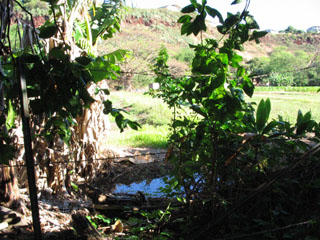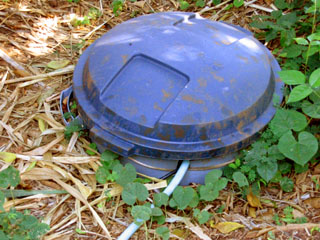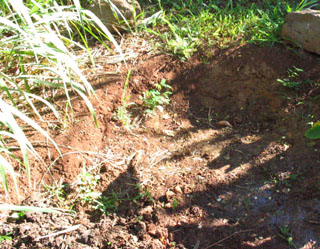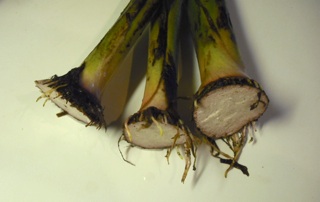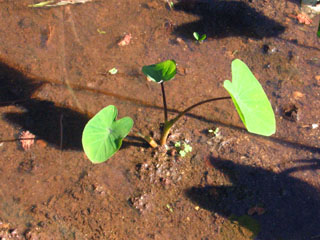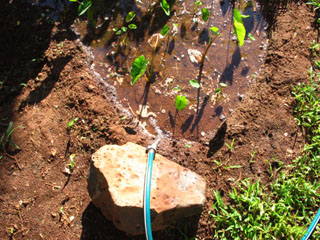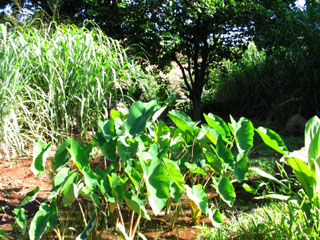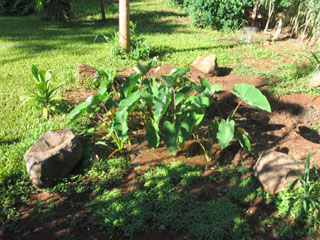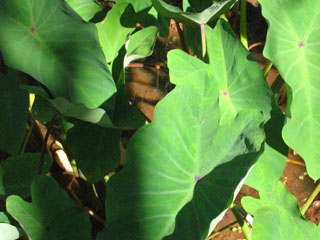SUBJECT: KAUAI TARO FARMING
SOURCE: JUAN WILSON juanwilson@earhlink.net
POSTED: 24 May 2005 - 9:00am HST
Doing it in the back yard in Hanapepe Valley
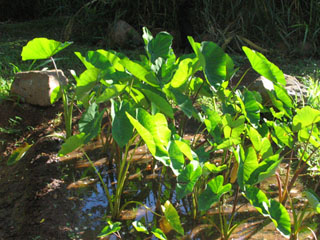
A small patch of dryland (Chinese) taro growing in my backyard
Backyard Taro Farmer Friends of ours live in Waimea Valley and grow dryland taro. They have made dinner for my wife and I several times and featured taro a staple much like potato in stews and soups. One ahi-taro stew convinced me to try growing my own dryland taro. I live in Hanapepe Valley surrounded on two sides by flooded taro fields.My property is on fill about two feet above the land nearby, which in turn is about a foot above the taro fields. Hanapepe Valley can be pretty dry and nasty for a gardener without ditch water. Fortunately, along the backside of my yard is a ditch with intermittently flowing water. This water is truly a blessing but it was a bit too low to flow into my yard. I decided I would use a sump pump to raise the water.
At a low point in my yard a few feet from the ditch I dug a hole deep enough to bury a standard plastic trash can. This was low enough to be below the bottom of the ditch. I dug a trench from the trashcan to the ditch and connected the two together with a 4" PVC pipe. One end of the pipe was inserted into the trashcan through a carefully cut hole I made with a boxcutter about 18" from the bottom of the can. The other end of the pipe sat at the bottom of the ditch with a raingutter screen over the end to keep out big litter. Inside the trashcan I covered the end of the pipe with a pantyhose to filter out smaller debris from the ditch.
I bought an inexpensive
($70) 110 volt sump pump from Ace Hardware that is submersible and
just hangs in the water in the trashcan with a garden hose attached
to it to tap the water. Note, be careful with the pump. Don't run
it when the ditch is dry. For more money you can get a more rugged
pump with a float switch. I decided to go lowball on the pump.
The area I dug for my lo`i was about four feet wide and eight feet long. I backfilled the hole with about 12" of soil that consisted mostly of a mixture of horse manure, sand, vegetable compost and some dirt. This material was dampened with ditch water. until it was a slurry about the consistency of wet concrete. My friend gave my about twenty starter sprouts (holi). A holi consists of the stem of the plant with the leaves and "corn" removed as harvest. Just a portion of the top rim of the taro "corn" is left on the stem. The corn is the rooted potato like body of the taro below the ground that is eaten. My friend suggested that when harvesting taro corn to cut the top so that a few root buds are left with the stem.
That's a little more rim than is shown in the picture above. The holi above is from a fully matured plant. The holi my friend gave me were tiny starters. These we planted by simply pushing them into the slurry of soil we had dampened. They were about a foot apart. Everyday I flooded the lo`i with ditch water. Many of the holi withered back until I thought I would lose many of them.
I kept watering.
After about a week new leaf sprouts began appearing and eventually
all the holi survived and bore new leaves. This delighted my friend
from Waimea who was worried I'd lose much of what we planted. There are only a few minutes a day needed to tend the plants. Daily watering and occasional weeding is about it. There is something deeply satisfying about the sound of the water running into the lo`i and the sight of new taro leaves waving in the tradewinds. The weeding is easy if you flood everyday and have the proper density of taro. Weeding is made easier if you keep the lo`i narrow enough to reach the center. You really don't want to walk in the lo`i and compress the soil.
In about two months many of the plants had grown to over 12" high. A few had reached 18" and were beginning to crowd each other. I made one expansion to plant new small sprouts and relocate some smaller plants that were being crowded. I found using a posthole digger to pluck the plants and soil in one stroke worked well.
It as been a great pleasure for me to watch my taro grow. I feel more a part of the Hawaiian culture and am looking forward to trading stories about my experience with some of the old timers here in the valley. |
Pau
